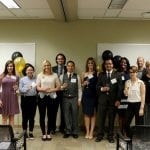Areas of Research
Visit our research website: https://sciences.ucf.edu/chemistry/dmk-biochemlab/
Dr. Kolpashchikov’s lab group develops DNA nanomachines for biomedical applications. Their DNA machines can recognize RNA molecules with high selectivity, unwind their secondary structures and either detect or cleave them. The DNA machines can be used as highly specific sensors for biological RNA. Alternatively, they can be used for suppression of cancer cells or RNA-containing viruses. The plan is to use the machines for anti-viral and anti-cancer treatment.
Publications
Click here for complete list of publications
2018
- Bakshi S. F., Guz N., Zakharchenko A., Deng H., Tumanov A., Woodworth C. D., Minko S., Kolpashchikov D. M., Katz E. (2018) Nanoreactors Based on DNAzyme-Functionalized Magnetic Nanoparticles Activated by Magnetic Field. Nanoscale, 10, 1356–1365.
2017
- Fedotova T. A. Kolpashchikov D. M. (2017) Liquid-to-Gel Transition for Visual and Tactile Detection of Biological Analytes. Chem. Commun. (Camb.), 53, 12622 – 12625. This paper was featured on the front cover of the journal. In addition, this article was highlighted by Chemistry World, monthly chemistry news magazine published by the Royal Society of Chemistry https://www.chemistryworld.com/news/tactile-alternative-to-colour-changes/3008395.article
- Kamar O., Sun S. C., Lin C. H., Chung W. Y., Lee M. S., Liao Y. C., Kolpashchikov D. M., Chuang M. C. (2017) A mutation-resistant deoxyribozyme OR gate for highly selective detection of viral nucleic acids. Chem. Commun. (Camb.), 53, 10592-10595.
- Bakshi S.F., Guz N., Zakharchenko A., Deng H., Tumanov A., Woodworth C. D., Minko S., Kolpashchikov D. M., Katz E. (2017) Magnetic Field-Activated Sensing of mRNA in Living Cells. Journal of the American Chemical Society, 139, 12117-12120.
- Smith A., Kolpashchikov D. M. (2017) Divide and Control: Comparison of Split and Switch Hybridization Sensor. ChemistrySelect, 2, 5427-5431.
- Kikuchi N., Kolpashchikov D. M. (2017) Universal Split Spinach Aptamer (USSA) Probe for Nucleic Acid Analysis and DNA/RNA Computation. Chem. Commun. (Camb.), 53, 4977-4980.
- Campbell E. A., Peterson E., Kolpashchikov D. M. (2017) Self-Assembling Molecular Logic Gates Based on DNA Crossover Tiles. ChemPhysChem, 18, 1730-1734.
- Bengtson H. N., Homolka S., Niemann S., Reis A. J., da Silva P. E. A, Gerasimova Y. V., Kolpashchikov D. M. Rohde K. H. (2017) Multiplex Detection of Extensively Drug Resistant Tuberculosis using Binary Deoxyribozyme Sensors. Biosensors & Bioelectronics, 94, 176-183
- Mills D. M. Calvo-Marzal P., Pinzon J. M., Armas S., Kolpashchikov D. M., Chumbimuni-Torres K.Y.* (2017) A Single Electrochemical Probe Used for Analysis of Multiple Nucleic Acid Sequences. Electroanalysis, 29, 873–879.
- Gamella M., Zakharchenko A., Guz N., Masi M., Minko S., Kolpashchikov D. M., Iken H., Poghossian A., Schöning, M. J. Katz E.* (2017) DNA Computing Systems Activated by Electrochemically-Triggered DNA Release from a Polymer-Brush-Modified Electrode Array. Electroanalysis, 29, 398–408.
Syllabi
Outreach
Motivated, open-minded students are welcome in our lab. Students will be involved in all aspects of scientific research including literature search, experiment design, data collection and analysis, poster and oral presentations, publishing in scientific journals. Techniques that students will be exposed in our lab include gel electrophoresis, UV/vis and fluorescent spectroscopy, SELEX, bioorganic synthesis (including DNA synthesis), chromatography (including HPLC), photochemistry and others.
Teaching: Biochemistry I course (BCH4053)
The course is focused on chemical structure and functions of the four major classes of biological molecules in the following order: carbohydrates, nucleic acids, proteins and lipids. The course builds on students’ prior knowledge of physical and organic chemistry to understand architecture of biological molecules and how this architecture makes biomolecules functionally active. The complex molecular interplay is illustrated by protein-nucleic acid interactions, membrane transport and biological signaling. ‘Introduction to metabolism’ prepares students for Biochemistry II course.
Each student in the class receives an individual score by the end of semester. Students who collected the highest scores during previous terms are listed below.
|
Student Name
|
Score
|
Score (%)
|
Term
|
Total number of students in the class
|
| Christopher Reilly |
976
|
97.6%
|
Fall 2009
|
148
|
| Nicole Mailloux |
947
|
94.7%
|
Spring 2010
|
223
|
| David Delapena |
934
|
93.4%
|
Fall 2010
|
184
|
| Patricia Prieto |
980
|
98.0%
|
Spring 2010
|
240
|
| Lauren Holliday |
980
|
98.0%
|
Fall 2011
|
300
|



